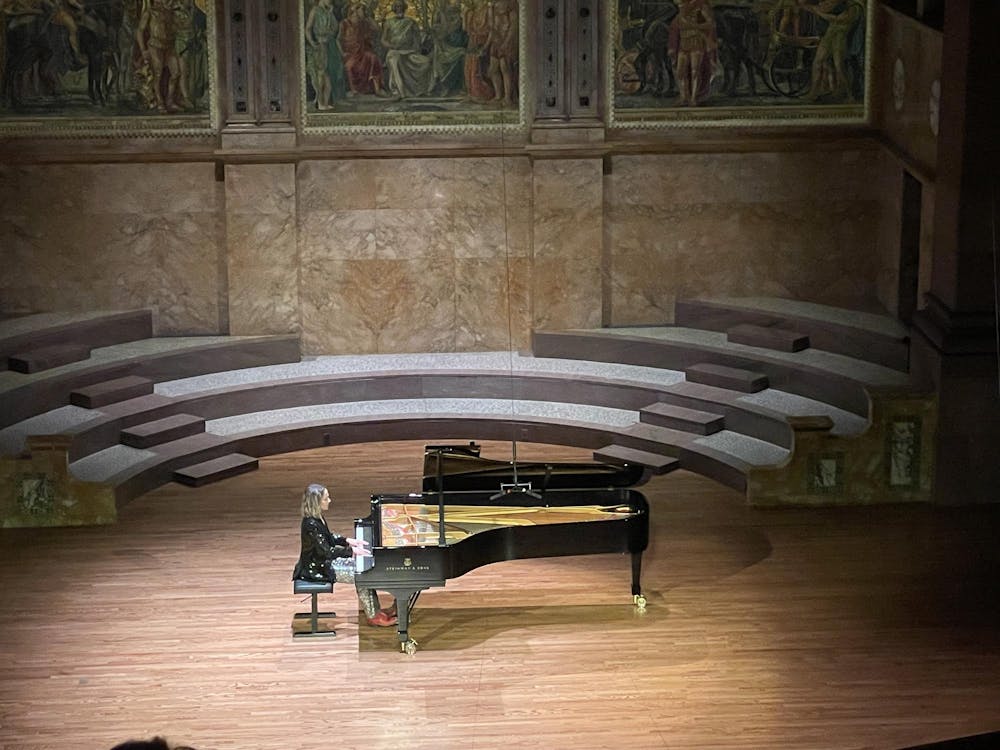The eminent French pianist Hélène Grimaud performed a classic combination of “B” composers — Beethoven, Brahms, and Bach (arranged by a slightly less famous B, Busoni) — in a sold-out Richardson Auditorium at her Princeton University Concert series debut on January 24.
While well-known pieces run the risk of being standard or cliché, her unique style made them sparkle — just like her outfit.
Grimaud took her time at the start of Beethoven’s Piano Sonata No. 30, Op. 109, allowing the first few notes to hang in the air before she continued. The piece’s moodiness was reflected in Grimaud’s seemingly spontaneous interpretations, with moments of gentle delicacy in the first movement and clashing eruptions in the second. Grimaud’s use of the sustaining pedal and brief pauses in between the three movements almost morphed them into one. Crescendos and diminuendos ebbed and flowed, fueled by deliberate pauses at the end of long phrases. She took another long pause before playing the last note, hunching over as the crisp note reverberated in the hushed auditorium. Though the program overall was exceptional, Beethoven did not feel like her strongest performance.
Grimaud brought out the rich musicality and harmonic language in Brahms’ Intermezzi, Op. 117. Compared to her recording of the same three Intermezzi on her recent “Schuman and Brahms” album, Grimaud articulated the first melody much more slowly here. The bittersweet sentiment was enhanced by her control of rubato – slightly slowing down at the end of phrases – and her ease in navigating abrupt transitions: from misty, brooding arpeggios to calm, yearning chords. Her pauses here appeared more natural here than they had with Beethoven, and the choice suited the angst-ridden and bittersweet undertones of the Brahms.
After intermission, her technical and dynamic control were again clear in Brahms’ Fantasies, Op. 116, beginning with nimble right-hand octaves and thunderous left-hand chords. Her use of the pedal gave these seven pieces fluidity despite their density, seeming to blur them into one overarching narrative. The last Fantasia particularly struck me as she executed the clear melodies with hands that almost seemed to be floating through space.
Finally, Grimaud unleashed a seemingly effortless performance of the great Chaconne from Bach’s Partita in D minor for solo violin, arranged by Ferruccio Busoni. She remained completely in control of each rise and fall of the phrases, enhancing each resolution with pauses and with the articulation of trills. In many parts of the piece, her left-hand octaves were so quick that separate notes almost blended as one. As she wrapped up the chord-filled finale, the audience was even more quiet and attentive than it had been the whole evening.
Grimaud played three encores: Rachmaninoff’s Études Tableaux Op. 33: No. 2 in C Major (Allegro) & No. 3 in C Minor (Grave), and Valentin Silvestrov’s Bagatelles Op. 1: No. 2 in E Minor (Moderato “Lontano”). Her fearless playing of Rachmaninoff’s enigmatic etudes produced a collage of loud ascending left-hand chords and light right-hand melodies, naturally wavering from one to the other. As she had done throughout the evening, she took a long, luxuriant pause before the last phrase of Silvestrov’s bagatelle, which brought a change in tonal color like a flower blooming.
Chloe Lau is a staff Prospect writer and a staff Features writer for the ‘Prince.’ She can be reached at chloelau[at]princeton.edu.








